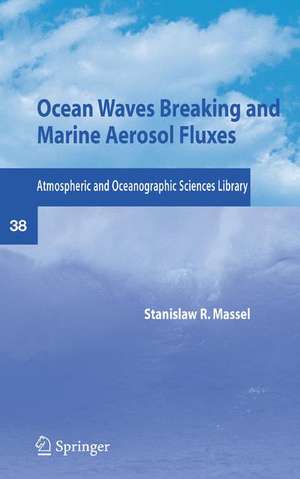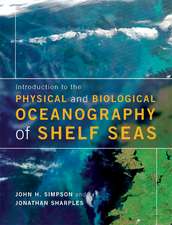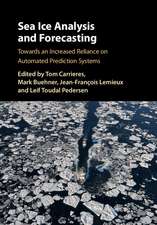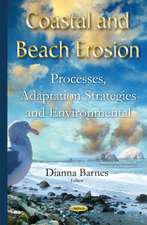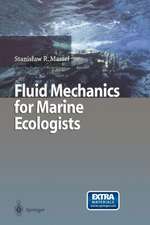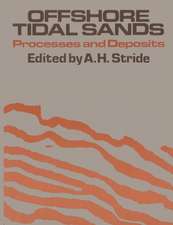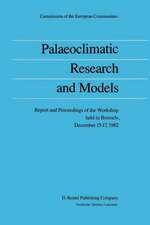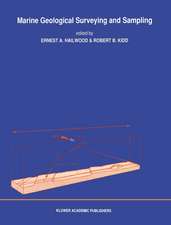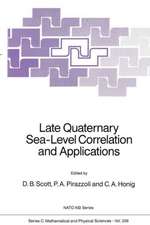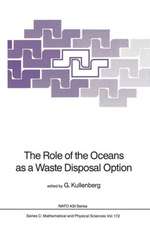Ocean Waves Breaking and Marine Aerosol Fluxes: Atmospheric and Oceanographic Sciences Library, cartea 38
Autor Stanislaw R. Masselen Limba Engleză Hardback – 7 iun 2007
| Toate formatele și edițiile | Preț | Express |
|---|---|---|
| Paperback (1) | 946.72 lei 6-8 săpt. | |
| Springer – 23 noi 2010 | 946.72 lei 6-8 săpt. | |
| Hardback (1) | 952.89 lei 6-8 săpt. | |
| Springer – 7 iun 2007 | 952.89 lei 6-8 săpt. |
Din seria Atmospheric and Oceanographic Sciences Library
- 18%
 Preț: 1996.98 lei
Preț: 1996.98 lei - 18%
 Preț: 957.75 lei
Preț: 957.75 lei - 18%
 Preț: 963.15 lei
Preț: 963.15 lei - 18%
 Preț: 1156.64 lei
Preț: 1156.64 lei - 18%
 Preț: 948.61 lei
Preț: 948.61 lei - 18%
 Preț: 946.55 lei
Preț: 946.55 lei - 18%
 Preț: 1224.18 lei
Preț: 1224.18 lei - 18%
 Preț: 1226.90 lei
Preț: 1226.90 lei - 18%
 Preț: 952.26 lei
Preț: 952.26 lei - 15%
 Preț: 639.90 lei
Preț: 639.90 lei - 18%
 Preț: 1229.58 lei
Preț: 1229.58 lei - 18%
 Preț: 1418.98 lei
Preț: 1418.98 lei - 18%
 Preț: 950.66 lei
Preț: 950.66 lei - 24%
 Preț: 801.40 lei
Preț: 801.40 lei - 18%
 Preț: 1237.30 lei
Preț: 1237.30 lei - 18%
 Preț: 1225.79 lei
Preț: 1225.79 lei - 18%
 Preț: 960.42 lei
Preț: 960.42 lei - 18%
 Preț: 1392.46 lei
Preț: 1392.46 lei - 18%
 Preț: 947.18 lei
Preț: 947.18 lei - 18%
 Preț: 1235.76 lei
Preț: 1235.76 lei - 18%
 Preț: 1541.47 lei
Preț: 1541.47 lei - 18%
 Preț: 1390.59 lei
Preț: 1390.59 lei - 18%
 Preț: 1226.73 lei
Preț: 1226.73 lei - 18%
 Preț: 974.67 lei
Preț: 974.67 lei - 18%
 Preț: 952.40 lei
Preț: 952.40 lei - 18%
 Preț: 954.45 lei
Preț: 954.45 lei -
 Preț: 390.25 lei
Preț: 390.25 lei - 20%
 Preț: 585.98 lei
Preț: 585.98 lei
Preț: 952.89 lei
Preț vechi: 1162.06 lei
-18% Nou
Puncte Express: 1429
Preț estimativ în valută:
182.36€ • 198.01$ • 153.18£
182.36€ • 198.01$ • 153.18£
Carte tipărită la comandă
Livrare economică 22 aprilie-06 mai
Preluare comenzi: 021 569.72.76
Specificații
ISBN-13: 9780387366388
ISBN-10: 0387366385
Pagini: 316
Ilustrații: XVI, 316 p.
Dimensiuni: 156 x 235 x 21 mm
Greutate: 0.66 kg
Ediția:2007
Editura: Springer
Colecția Springer
Seria Atmospheric and Oceanographic Sciences Library
Locul publicării:New York, NY, United States
ISBN-10: 0387366385
Pagini: 316
Ilustrații: XVI, 316 p.
Dimensiuni: 156 x 235 x 21 mm
Greutate: 0.66 kg
Ediția:2007
Editura: Springer
Colecția Springer
Seria Atmospheric and Oceanographic Sciences Library
Locul publicării:New York, NY, United States
Public țintă
Professional/practitionerCuprins
Basic processes near the air—sea interface.- Mechanics of steep and breaking waves.- Spectral and statistical properties of ocean waves.- Experimental insights into mechanisms of wave breaking.- Wave breaking criteria and probability of breaking.- Energy dissipation due to wave breaking.- Whitecap coverage of the sea surface.- Fundamentals of marine aerosols.- Marine aerosol fluxes.- Aerosol flux as a function of sea state parameters.- Seasonal dependence of aerosol fluxes in the Baltic Sea.
Recenzii
From the reviews:
"Massel’s new book describes how to model wave breaking and continues on to show how to use breaking wave models to estimate the production rate of the sea-salt aerosol at the ocean’s surface. … I like the production quality of this book. It has a comfortable size, pleasing font style and size, and sufficient white space to make for easy reading or scanning. The many figures are uniformly styled and formatted … . valuable reference text for researchers studying air–sea interaction and marine aerosols." (Edgar L Andreas, Bulletin of the American Meteorological Society, March, 2009)
"Massel’s new book describes how to model wave breaking and continues on to show how to use breaking wave models to estimate the production rate of the sea-salt aerosol at the ocean’s surface. … I like the production quality of this book. It has a comfortable size, pleasing font style and size, and sufficient white space to make for easy reading or scanning. The many figures are uniformly styled and formatted … . valuable reference text for researchers studying air–sea interaction and marine aerosols." (Edgar L Andreas, Bulletin of the American Meteorological Society, March, 2009)
Notă biografică
Stanislaw Massel is currently a professor and the Director of the Institute of Oceanology in Sopot Poland.
Textul de pe ultima copertă
Ocean Waves Breaking and Marine Aerosol Fluxes
Stanislaw R. Massel
Institute of Oceanology of the Polish Academy of Sciences, Sopot, Poland
This book presents a comprehensive study on the breaking of surface waves induced by wind and the relationship of breaking rate with marine aerosol fluxes. The book draws attention to the theoretical and experimental achievements in the study of wave breaking phenomena in deep water seas. In particular, it deals with the important problems of energy dissipation and the estimation of energy loss due to wave breaking in deep waters. The rationale behind existing methods and practical outcomes for the estimation of whitecap coverage of the sea surface and energy dissipation rate are given in detail.
The book also focuses on the fundamentals of marine aerosols and their generation. The text provides a comprehensive overview of the currently available experimental data on marine aerosol fluxes and presents theoretical methodology of the estimation of the intensity of sea aerosol production. The systematic analysis leads to a novel approach in the development of links between aerosol production with sea state parameters and its seasonal variation in deep water seas.
The book is intended for professionals and researchers in the areas of ocean physics and meteorology and also as a useful book for graduate students, PhD students, postdoctoral students, and engineers working on ocean environmental problems.
Stanislaw R. Massel
Institute of Oceanology of the Polish Academy of Sciences, Sopot, Poland
This book presents a comprehensive study on the breaking of surface waves induced by wind and the relationship of breaking rate with marine aerosol fluxes. The book draws attention to the theoretical and experimental achievements in the study of wave breaking phenomena in deep water seas. In particular, it deals with the important problems of energy dissipation and the estimation of energy loss due to wave breaking in deep waters. The rationale behind existing methods and practical outcomes for the estimation of whitecap coverage of the sea surface and energy dissipation rate are given in detail.
The book also focuses on the fundamentals of marine aerosols and their generation. The text provides a comprehensive overview of the currently available experimental data on marine aerosol fluxes and presents theoretical methodology of the estimation of the intensity of sea aerosol production. The systematic analysis leads to a novel approach in the development of links between aerosol production with sea state parameters and its seasonal variation in deep water seas.
The book is intended for professionals and researchers in the areas of ocean physics and meteorology and also as a useful book for graduate students, PhD students, postdoctoral students, and engineers working on ocean environmental problems.
Caracteristici
Bridges the gap between generalized texts and specialized texts on oceanography First ocean wave title to specifically focus on wave breaking phenomenon Can be used as a textbook for graduate students, Ph.D students and postdoctoral students due to its basic and educational character
